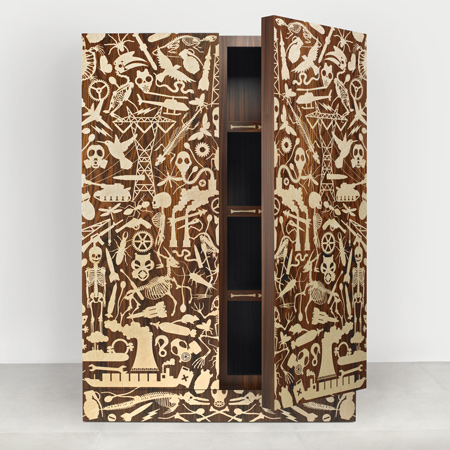Artists Studio Job will present a collection of furniture decorated with marquetry at the Carpenters Workshop Gallery in London.
Called Industry Series, the pieces are made of Indian rose wood inlaid with maple silhouettes of animals, insects and birds alongside weapons, industrial buildings and skeletons.
The work will be on show 20 March - 8 May 2010.
See all our stories about Studio Job in our special category.
The following information is from Studio Job:
Following the great success of the Telling Tales exhibition at the Victoria and Albert Museum, the Carpenters Workshop Gallery proudly presents the Industry series by Studio Job.
Job Smeets and his partner Nynke Tynagel seem to delight in the physical potential and malleability of the various materials they incorporate into their designs. Beautifully crafted and finely finished, they create highly ornamented pieces, which often contain dark and satirical content through their brave confrontation with the current attitudes and condition of the modern world.
Each work in the Industry series uses traditional and contemporary iconography and has been stripped down to its elements. The silhouettes stand bold with the white bird’s eye maple inlaid within the Indian rosewood setting. Animals and insects mingle with industrial buildings, warfare weaponry and other such products of capital. Featuring hummingbirds, seahorses, dragonflies, skeletal figures, and butterflies alongside tanks, helicopters, pylons, smoke, grenades, fighter planes and gasmasks, the viewer is forced to recognise the dichotomy between the natural or organic, and the manmade or destructive. Presented as if fossilised, there is an overwhelming sense that both will have their downfall and eventually become imbedded within history.
Perhaps the irony comes not simply from their opposition but also from the fact that the natural and the artificial are very much cohabitants in the twenty first century. The Industry series offers a poignant commentary on such an environment, each piece being highly evocative in its own right. The finish of each Industry piece references the seventeenth-century marquetry methods of André- Charles Boulle (1642-1732), and whilst Studio Job cut the veneers using contemporary laser technology, the positioning of each piece of the veneer is undoubtedly still an intensely handcrafted process. The strict symmetry in each piece, and most notably the Dressoir, maintains the integrity of the aesthetic, and given the simple, clean lines of the furniture, produces a powerfully balanced work, whilst also encouraging a contemplation of the notion of repetition; the phenomenon of cloning in the natural world and of mass production in the industrial sector. Each design piece in the series has been employed by Studio Job as a ‘canvas’ on which to construct a modern memento mori; a plethora of visual metaphors that act as signifiers either of bucolic nature or of mass-destruction as associated with industrialism.
To compliment the five Industry pieces, Carpenters Workshop Gallery has specially commissioned Studio Job to create two new spectacular light-works entitled Wrecking Ball Lamp and Crane Lamp, with which they have further developed the dialogue that began with the original works.
Living and working together, Studio Job suggests:
“Maybe sometimes we are designers and maybe sometimes we are architects. Sometimes man and wife, sometimes just artists.”
An imposing piece, with a commanding silhouette, the Industry Cabinet features its apocalyptic imagery in a strictly symmetrical layout on the expansive front, with the formation in the centre of two gas masks supposedly breathing in the smoke bellowing from a power station. The effect is perhaps reminiscent of a Rorschach inkblot pattern. When opened, the substantial doors reveal a sparse interior, divided into eight identically sized compartments. Inside, the Indian rosewood is interrupted only by the solid brass hinges which sit flush to the surface, and the silhouettes of bones across the horizontal slats, suggesting the ultimate degeneration of mankind.
This striking screen presents a contemporary design approach to a conventional furniture object and provides an ideal backdrop for the elaborate imagery of death and destruction that defines the Industry Series. As with the screen in Studio Job’s Perished Series, skeletons populate the Industry screen to create a fossilised effect, though they are now joined by hazardous and deadly chemicals and instruments, presented as if they were ‘urban fossils’.

